How To Force Steam To Check For Updates
All Windows versions have a congenital-in characteristic for automatically updating root certificates from the Microsoft websites. MSFT, as part of the Microsoft Trusted Root Document Program, maintains and publishes a listing of trusted certificates for clients and Windows devices in its online repository. If the verified certificate in its certification chain refers to the root CA that participates in this program, the system will automatically download this root certificate from the Windows Update servers and add it to the trusted ones.
Windows updates a trusted root certificate list (CTL) once a week. If Windows doesn't have direct access to the Windows Update, the organization won't exist able to update the root certificates. So a user may take some troubles when browsing websites (which SSL certificates are signed by an untrusted CA – see the article near the "Chrome SSL fault: This site can't provide a secure connection"), or with installing/running signed scripts and apps.
In this article, we'll try to discover out how to manually update the list of root certificates in TrustedRootCA in asunder (isolated) networks or computers/servers without directly Internet access.
Contents:
- Managing Trusted Root Certificates in Windows 10 and 11
- How to Disable/Enable Automated Root Certificates Update in Windows?
- Certutil: Download Trusted Root Certificates from Windows Update
- Document Trust List (STL) in Windows
- Updating Trusted Root Certificates via GPO in an Isolated Environment
- How to Update Trusted Root Certificates in Windows 7?
- Updating Root Certificates on Windows XP Using the Rootsupd.exe Tool
Annotation. If your computers access the Internet through a proxy server, Microsoft recommends that you open direct access (bypass) to Microsoft Web sites to automatically renew root certificates. However, information technology isn't e'er possible or applicative due to corporate restrictions.
Managing Trusted Root Certificates in Windows 10 and 11
How to encounter the list of trusted root certificates on a Windows computer?
- To open up the root document store of a computer running Windows xi/ten/eight.i/seven or Windows Server 2022/2019/2016, run the mmc.exe console;
- Select File -> Add/Remove Snap-in, select Certificates (certmgr) in the list of snap-ins -> Add;
- Select that you want to manage certificates of local Estimator account;
- Adjacent -> OK -> OK;
- Expand the Certificates node -> Trusted Root Certification Authorities Store. This department contains the list of trusted root certificates on your figurer.
In the mmc console, you can view information about any certificate or remove it from trusted ones.
You tin can besides get a list of trusted root certificates with their expiration dates using PowerShell:
Go-Childitem cert:\LocalMachine\root |format-list
Yous tin list the expired certificates, or which expire in the next 60 days:
Get-ChildItem cert:\LocalMachine\root|Where {$_.NotAfter -lt (Get-Date).AddDays(sixty)}|select NotAfter, Field of study

For security reasons, it's recommended that you periodically check the certificate trust shop on your calculator for suspicious and revoked certificates using the Sigcheck tool. This tool allows you to compare the list of certificates installed on the reckoner with the listing of root certificates on the Microsoft website (you can download an offline file with upwards-to-engagement certificates authrootstl.cab).
You can manually transfer the root document file between Windows computers using the Export/Import options.
- Yous can consign whatsoever document to a .CER file by clicking on it and selecting All Tasks -> Export;
- Yous tin can import this document on another estimator using the selection All Tasks -> Import.
How to Disable/Enable Automatic Root Certificates Update in Windows?
Equally we mentioned, Windows automatically updates root certificates. You can enable or disable certificate renewal in Windows through a GPO or the registry.
Open the Local Group Policy Editor (gpedit.msc) and go to Estimator Configuration -> Administrative Templates -> Arrangement -> Net Advice Management -> Net Advice.
The Plow off Automatic Root Certificates Update option in this section allows you to disable automatic updating of root certificates through the Windows Update sites. Past default, this policy is non configured and Windows always tries to automatically renew root certificates.
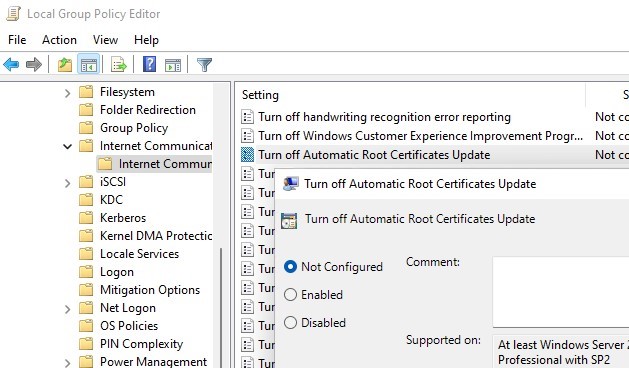
If this GPO choice is non configured and the root certificates are not automatically renewed, bank check if this setting is manually enabled in the registry. Check the value of the registry parameter using PowerShell:
Become-ItemProperty -Path 'HKLM:\Software\Policies\Microsoft\SystemCertificates\AuthRoot' -Name DisableRootAutoUpdate

If the command returns that the value of the DisableRootAutoUpdate registry parameter is 1, so the updating of root certificates is disabled on your computer. To enable it, alter the parameter value to 0.
Certutil: Download Trusted Root Certificates from Windows Update
Certutil.exe CLI tool can exist used to manage certificates (introduced in Windows 10, for Windows 7 is bachelor as a separate update). It can be used to download an up-to-date list of root certificates from Windows Update and salvage information technology to an SST file.
To generate an SST file on a estimator running Windows 10 or 11 and having direct access to the Internet, open the elevated command prompt and run the command:
certutil.exe -generateSSTFromWU C:\PS\roots.sst
Updated SST file. CertUtil: -generateSSTFromWU command completed successfully.

As a result, an SST file containing an up-to-date list of root certificates will appear in the target directory. Double-click to open it. This file is a container containing trusted root certificates.
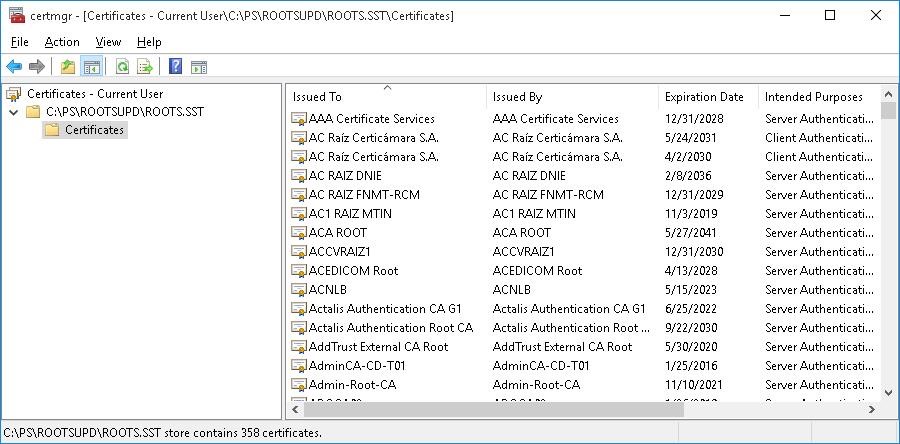
As y'all can see, a familiar Certificate Management snap-in opens, from which yous tin export any of the certificates y'all have got. In my case, there take been 358 items in the listing of certificates. Plain, it is not rational to export the certificates and install them ane by one.
Tip. The certutil -syncWithWU command can be used to generate individual document files. The certificates obtained in this way tin can be deployed to Windows devices using GPO.
You tin employ PowerShell script to install all certificates from the SST file and add together them to the list of trusted root certificates on a computer:
$sstStore = ( Get-ChildItem -Path C:\ps\rootsupd\roots.sst )
$sstStore | Import-Certificate -CertStoreLocation Cert:\LocalMachine\Root
Run the certmgr.msc snap-in and brand sure that all certificates have been added to the Trusted Root Certification Authorization. In my example on Windows 11, the number of root certificates increased from 34 to 438.
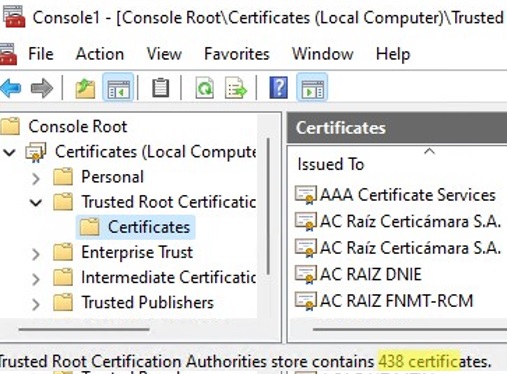
A clean copy of Windows after installation contains but a small number of certificates in the root shop. If the computer is continued to the Internet, the remainder of the root certificates volition be installed automatically (on demand) if your device access an HTTPS site or SSL certificate that has a fingerprint from Microsoft CTL in its trust chain. Therefore, every bit a rule, there is no demand to immediately add together all certificates that Microsoft trusts to the local certification store.
Certificate Trust List (STL) in Windows
A Certificate Trust List (CTL) is merely a listing of data (such as certificate hashes) that is signed by a trusted political party (by Microsoft in this example). The Windows customer periodically downloads from Windows Update this CTL, which stores the hashes of all trusted root CAs. It should be understood that this CTL doesn't comprise the certificates themselves, merely their hashes and attributes (for example, Friendly Proper noun). Windows devices can download a trusted certificate from Certificate Trust Listing on demand.
You can manually download and install the CTL file. To exercise information technology, download the file http://ctldl.windowsupdate.com/msdownload/update/v3/static/trustedr/en/authrootstl.cab (updated twice a month). Using whatsoever archiver (or fifty-fifty Windows Explorer), unpack the contents of the authrootstl.cab archive. It contains a single authroot.stl file.

The Authroot.stl file is a container with a list of trusted document thumbprints in Certificate Trust Listing format.
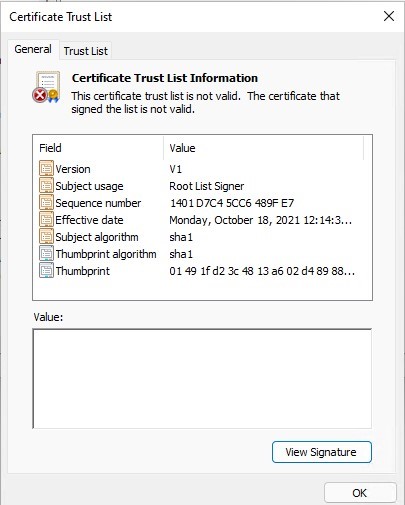
You can install this CTL file to a Trusted Root Certificate Dominance using the certutil command:
certutil -enterprise -f -v -AddStore "Root" "C:\PS\authroot.stl"

root "Trusted Root Certification Authorities" CTL 0 added to shop. CertUtil: -addstore control completed successfully.
You can also import certificates using the certificate management console (Trust Root Certification Authorities -> Certificates -> All Tasks -> Import). Specify the path to your STL file with certificate thumbprints.
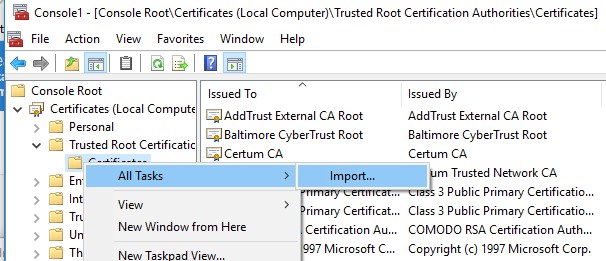
After you take run the command, a new section Document Trust List appears in Trusted Root Certification Authorities container of the Document Managing director console (certmgr.msc).
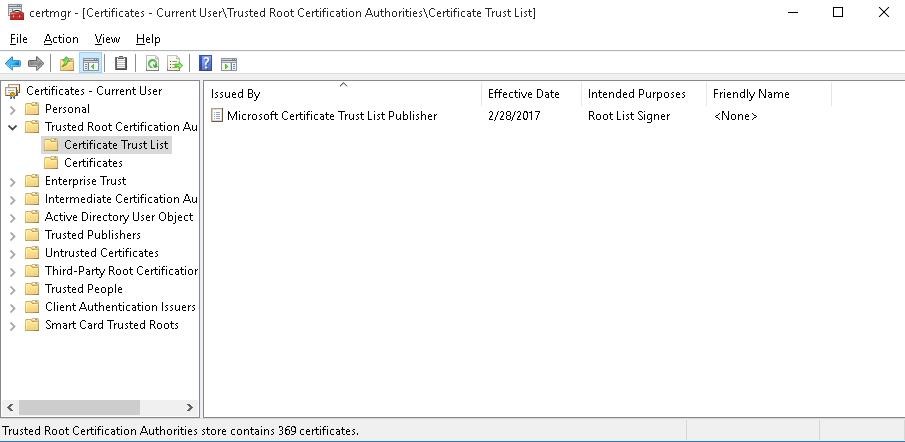
In the aforementioned way, yous can download and install the listing of the revoked (disallowed) certificates that have been removed from the Root Certificate Plan. To exercise it, download the disallowedcertstl.cab file (http://ctldl.windowsupdate.com/msdownload/update/v3/static/trustedr/en/disallowedcertstl.cab), excerpt it, and add it to the Untrusted Certificates store with the command:
certutil -enterprise -f -5 -AddStore disallowed "C:\PS\disallowedcert.stl"
Updating Trusted Root Certificates via GPO in an Isolated Environment
If you take the task of regularly updating root certificates in an Internet-isolated Active Directory domain, there is a slightly more than complicated scheme for updating local certificate stores on domain-joined computers using Group Policies. Y'all tin can configure root document updates on user computers in the disconnected Windows networks in several ways.
The first way assumes that you regularly manually download and copy a file with root certificates to your isolated network. Y'all tin download the file with electric current Microsoft root certificates equally follows:
certutil.exe –generateSSTFromWU roots.sst
Then the root certificates from this file can be deployed via SCCM or PowerShell Startup script in GPO:
$sstStore = (Get-ChildItem -Path \\fr-dc01\SYSVOL\woshub.com\rootcert\roots.sst )
$sstStore | Import-Certificate -CertStoreLocation Cert:\LocalMachine\Root
The second way is to download the actual Microsoft root certificates using the control:
Certutil -syncWithWU -f \\fr-dc01\SYSVOL\woshub.com\rootcert\
A number of root certificate files (CRT file format) volition appear in the specified shared network folder (including files authrootstl.cab, disallowedcertstl.cab, disallowedcert.sst, thumbprint.crt).
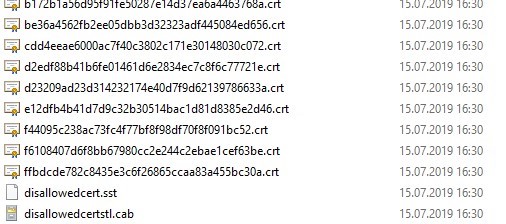
And then utilize the Group Policy Preferences to change the value of the registry parameter RootDirURLunder HKLM\Software\Microsoft\SystemCertificates\AuthRoot\AutoUpdate. This parameter should point to the shared network folder from which your Windows computers volition receive new root certificates. Run the domain GPMC.msc console, create a new GPO, switch to the edit policy mode, and aggrandize the section Estimator Configuration -> Preferences -> Windows Settings -> Registry. Create a new registry property with the post-obit settings:
- Activeness: Update
- Hive: HKLM
- Key path: Software\Microsoft\SystemCertificates\AuthRoot\AutoUpdate
- Value proper name: RootDirURL
- Blazon: REG_SZ
- Value data: file://\\fr-dc01\SYSVOL\woshub.com\rootcert\
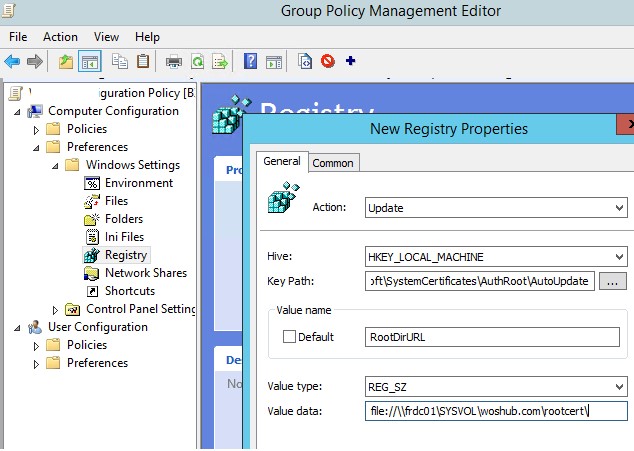
It remains to link this policy on a computer`southward OU and after updating GPO settings on the customer, check for new root certificates in the certstore.
The GPO parameter Turn off Automatic Root Certificates Update nether Reckoner Configuration -> Authoritative Templates -> System -> Internet Communication Management -> Cyberspace Communication settings should be disabled or not configured.
How to Update Trusted Root Certificates in Windows 7?
Despite the fact that Windows 7 is now is at the Cease of Back up stage, many users and companies still utilize it.
After installing a clean Windows 7 epitome, you may find that many modern programs and tools practise not piece of work on information technology as they are signed with new certificates. In particular, there have been complaints that .Internet Framework 4.eight or Microsoft Visual Studio (vs_Community.exe) cannot be installed on Windows 7 SP1 x64 without updating root certificates.
The installer manifest failed signature validation.
Or
Cyberspace Framework has not been installed because a certificate chain could not be built to a trusted root authorisation.
To update root certificates in Windows vii, you must first download and install MSU update KB2813430 (https://back up.microsoft.com/en-the states/topic/an-update-is-available-that-enables-administrators-to-update-trusted-and-disallowed-ctls-in-disconnected-environments-in-windows-0c51c702-fdcc-f6be-7089-4585fad729d6)
After that, you can use the certutil to generate an SST file with root certificates (on current or another calculator):
certutil.exe -generateSSTFromWU c:\ps\roots.sst
Now yous can import certificates into trusted ones:
Run MMC -> add snap-in -> certificates -> computer account > local computer. Right click Trusted root certification dominance, All Tasks -> Import, detect your SST file (in the file type select Microsoft Serialized Certificate Store — *.sst) -> Open -> Place all certificates in the following store -> Trusted Root Certification Government.
Updating Root Certificates on Windows XP Using the Rootsupd.exe Tool
In Windows XP, the rootsupd.exe utility was used to update the figurer`south root certificates. The list of root and revoked certificates in it was regularly updated. The tool was distributed as a separate update KB931125 (Update for Root Certificates). Permit'due south see if we can utilise it now.
- Download the rootsupd.exe utility using the following link
http://download.windowsupdate.com/msdownload/update/v3/static/trustedr/en/rootsupd.exe. At the moment (Jan 2021) the link doesn't piece of work, Microsoft decided to remove it from the public. Today you tin can download the rootsupd.exe from the Kaspersky website — http://media.kaspersky.com/utilities/CorporateUtilities/rootsupd.zip; - To install the Windows root certificates, but run the rootsupd.exe file. But we will attempt to examine its contents more advisedly. Extract the certificates from the executable file with the command:
rootsupd.exe /c /t: C:\PS\rootsupd - Certificates are stored in SST files, like authroots.sst, delroot.sst, etc. To remove or install certificates, yous can use the post-obit commands:
updroots.exe authroots.sst
updroots.exe -d delroots.sst
However, as you can meet, these certificate files were created on April 4, 2013 (almost a yr earlier the end of official support for Windows XP). Thus, since then the tool has not been updated and cannot be used to install up-to-date certificates.
Simply yous can use cerutil tool in Windows 10/eleven to download root.sst, re-create that file in Windows XP and install the certificate using updroots.exe:
updroots.exe c:\temp\roots.sst
There is information that the updroots.exe tool is not recommended for utilise in modern builds of Windows 10 1803+ and Windows 11, as it tin can break the Microsoft root CA on a device.
In this article, we looked at several means to update trusted root certificates on Windows network computers that are isolated from the Cyberspace (disconnected environment).
Source: http://woshub.com/updating-trusted-root-certificates-in-windows-10/
Posted by: shipmanyebere.blogspot.com

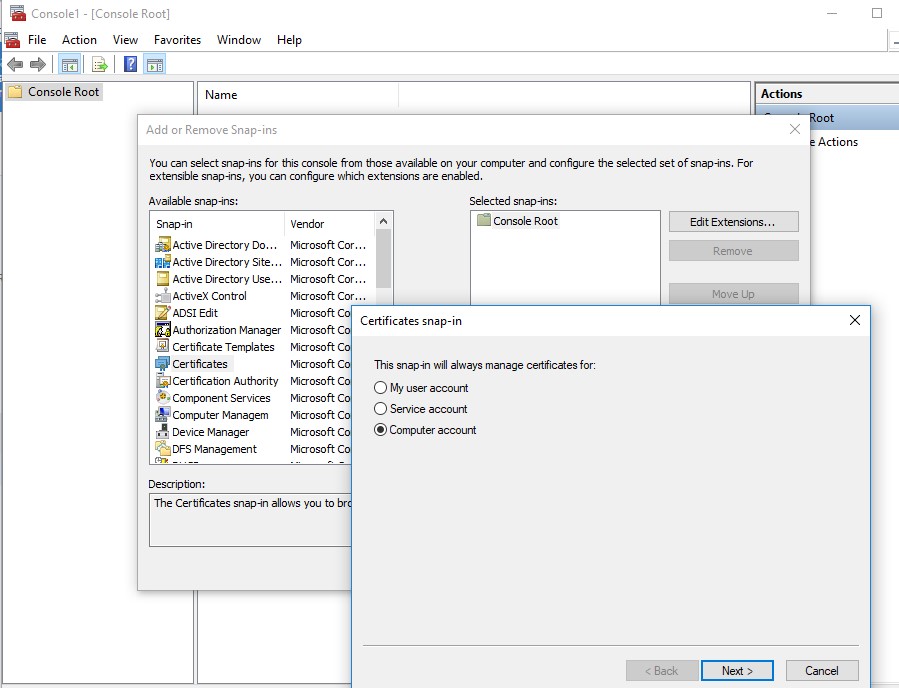

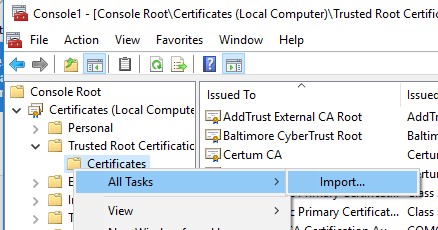
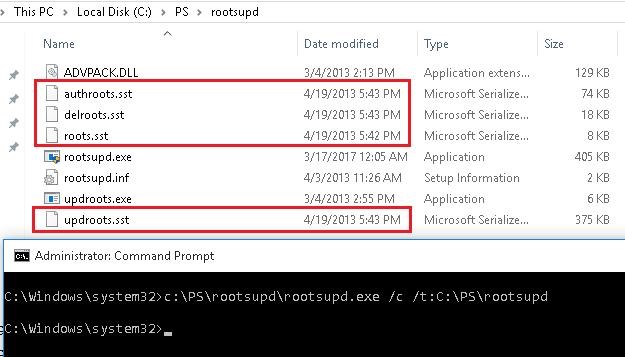

0 Response to "How To Force Steam To Check For Updates"
Post a Comment